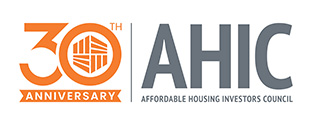Against the Headwinds: How Developers are Getting Deals Done in 2025
 At AHIC’s 2025 Fall Summit, the spotlight turned to developers—those on the front lines of making affordable housing projects a reality. Moderated by Ryan Sfreddo, Principal and CEO of Red Stone Equity Partners, the panel brought together Michael Riechman (Pivotal), Tricia Yarger (Pennrose), Welton Jordan (EAH Housing), and Julie DeGraaf (POAH).
At AHIC’s 2025 Fall Summit, the spotlight turned to developers—those on the front lines of making affordable housing projects a reality. Moderated by Ryan Sfreddo, Principal and CEO of Red Stone Equity Partners, the panel brought together Michael Riechman (Pivotal), Tricia Yarger (Pennrose), Welton Jordan (EAH Housing), and Julie DeGraaf (POAH).Collectively, these leaders represented thousands of affordable units across dozens of states, and their candid discussion underscored both the difficulties of today’s capital environment and the creative strategies that developers are deploying to keep projects moving forward.
A Tougher Capital Environment
Panelists began by acknowledging what everyone in the room already knew: the 2025 development climate is one of the most difficult in recent memory. Rising interest rates, prolonged project gestation periods, higher insurance costs, and political uncertainty have converged to put enormous strain on project feasibility.
- Relationships First: Yarger stressed that long-standing ties with lenders, investors, and syndicators are the lifeblood of getting deals closed. Pennrose has leaned heavily on trusted partners, while also marketing its pipeline early—even before credits are secured—to carve out space in CRA markets.
- Stress Testing: Developers across the panel described adding cushions into underwriting models, lowering assumed credit pricing, and modeling higher rates to ensure projects could survive shocks. “Ones that work, work. The others just have to go on the shelf,” Jordan said bluntly
- Uneven State Responses: State HFAs have responded differently to the stress. Some have stepped up with flexibility and additional resources, while others show “exhaustion” at repeated requests for help filling gaps. State tax credits are increasingly being used, though oversupply in some markets has depressed pricing.
The conversation quickly turned to the impact of recent legislative victories: expansion of the 9% program and the reduction of the 50% test to 25%. These changes are a double-edged sword.
- More Credits, More Competition: While the additional credits are celebrated, panelists cautioned that more deals chasing the same equity could exacerbate pricing pressure. Mixed-income transactions and deals with unconventional structures, like historic tax credit master leases, were already proving especially difficult to finance.
- Gap Funding Remains Critical: DeGraaf highlighted the importance of federal sources such as HOME and CDBG funds, which she called the “glue” holding deals together. She also pointed to local examples like Columbus, Ohio’s $250 million affordable housing bond as models of how municipalities can step in.
- Refocusing QAPs: Panelists urged that Qualified Allocation Plans should prioritize core housing needs rather than layering on features that add cost without improving outcomes. Investors and syndicators were encouraged to comment on QAPs and lend credibility to developer feedback, which otherwise risks sounding self-interested.
The construction environment remains volatile. Developers described dealing with a mix of flattening costs in some markets and unpredictable tariff impacts in others.
- Tariffs as a Moving Target: Developers likened tariffs to a “fluid” situation that changes by the week, making planning extremely difficult. Strategies include locking in pricing early, negotiating cost-sharing with contractors, and inserting escalation clauses that assign initial increases to contractors and later spikes to shared solutions.
- Labor and Timing: Labor shortages persist, and many contractors continue to price projects as though supply chain disruptions were still at their peak. Developers are pushing hard to shorten construction timelines and adjust reserves to reflect higher construction interest costs.
- Insurance Concerns: Beyond tariffs, the panel noted the increasing challenge of insurance markets—especially in disaster-prone regions like California and the Midwest. Building adequate reserves into deals has become essential to address climate-related risks.
The conversation also emphasized the link between development and long-term property performance.
- Design Standards: Developers are working to standardize features across their portfolios to reduce long-term maintenance costs and improve efficiency. Remote monitoring of utilities and investments in solar are already paying dividends in some portfolios.
- Feedback Loops: Many organizations now hold semi-annual meetings between development, operations, and asset management teams to review lessons learned and update design or underwriting practices accordingly.
- Partnerships with HFAs: Developers encouraged investors and syndicators to join them in advocating for predictable and transparent QAP processes. When HFAs impose requirements without funding to cover them, costs rise unnecessarily and feasibility suffers.
Beyond project dynamics, panelists addressed the health of their organizations. After years of pandemic disruption and now a tougher financing climate, developer balance sheets are under pressure.
- Capital Preservation: Riechman explained that Pivotal has deliberately slowed spending on pursuits and focused on preserving capital to weather delays.
- Cash Flow Management: Yarger described the month-to-month nature of cash management at Pennrose, noting the need to wring maximum value out of existing portfolios.
- Small Developers at Risk: DeGraaf raised concerns about smaller developers, who are disproportionately affected by delayed fee payments and rising costs. Without new tools or supports, many risk being squeezed out of the market entirely.
When asked what they expect from investors and syndicators, panelists emphasized three themes:
- Ease of Closing: Smooth execution is invaluable, since developers juggle multiple pressures during closing.
- True Partnership: Developers want partners who bring flexibility and creativity, not just transactional relationships.
- Local Knowledge: Investors who understand the realities of specific markets—state agencies, local politics, and timing—are far more effective partners.
Success Stories
Despite the challenges, the panel shared inspiring examples of persistence and creativity:
- Atlanta Turnaround: Pivotal stabilized a troubled Atlanta project by working with the local school district and police department to address community safety.
- Virgin Islands Recovery: Pennrose navigated contractor fraud on a Virgin Islands project, ultimately recapitalizing and restarting construction with the help of steadfast investor and lender partners.
- California Fire Damage: EAH overcame fire damage at a Southern California project with critical local support, limiting delays to just six months.
- Historic Redevelopment: POAH redeveloped a public housing site with innovative financing, including a $10 million low-interest construction loan backed by civic partners.
